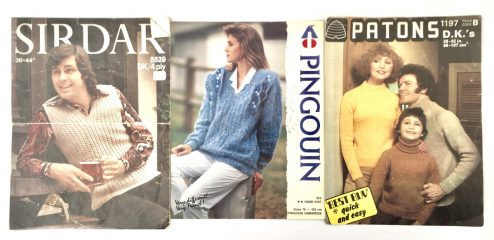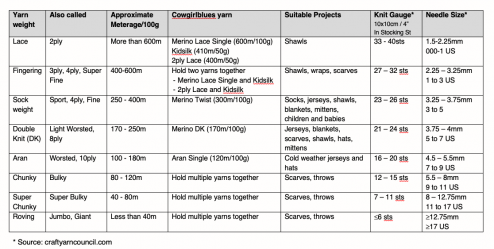What weight is this yarn?
I grew up in the 70s and 80s with terms like 3ply, 4ply and double knit describing yarn weights. A smaller number meant a finer wool. And that was about it. My mum and I would browse files of knitting patterns in our local wool shop, most published by yarn companies like Patons, Pingouin and Sirdar. We would buy the matching yarn, and go home and knit. My mother did most of the knitting back then 🙂

It’s different today …
Things have changed dramatically in the last 40 years. It’s all independent pattern designers, hand dyers and online shopping. We follow Instagram accounts from all over the world, and buy knitting patterns on Ravelry that may have been translated into 15 different languages. But when it comes to finding the right yarn for the project it’s really easy to get lost. There is far too much information. Suggested yarns are often not readily available to you. Yarn weights are unfamiliar. Not to mention gauge, needle size, yardage and meterage.
A helpful bit of background
Describing yarns as a “ply” used to make sense when there was a limited range of yarns on the market. The term ply means to twist. It is a technique used in the spinning process to twist several strands together and create a multi strand yarn, hence a 3ply or a 4ply yarn. In the old days this literally meant there were 3 strands of a very fine yarn twisted together to make a 3ply. A 4ply yarn had 4 strands, and if they were the same starting strands then obviously it was a thicker end result. Australians use the term 8ply when referring to a double knitting weight. Maybe this meant 8 of those same strands, and the double knitting then referenced the fact that it was double the 4ply thickness because of the 8 strands.
These days people start with a whole range of yarn thicknesses.
They might still twist 4 strands together, but the resulting 4ply could be anything from lace to chunky weight.
So the ply numbers don’t really make sense any more.
Did you know that some yarn weight descriptors are geographical?
- “Sport weight” is widely used in North America.
- Australians talk about “8 ply”
- British knitters use “3” and “4ply”
- Lots of people use “fingering”
- And “lace” seems to be used everywhere
Then to add to the confusion, and perhaps because there is no universal system, many yarn brands have created names for their yarn bases like Hedgehog Fibres’ Skinny Singles and Sporty Singles. We call our sport or sock-weight yarn Merino Twist. It started out being called Merino Sock, but because it’s 100% wool and doesn’t have a nylon component it’s not ideal to knit hard-wearing socks as many northern Europeans do. The “sock” descriptor was confusing to that market. So we changed it to Merino Twist.
You can see how complicated this whole system can become!
If you search the internet you’ll find loads of yarn weight comparisons. The Craft Yarn Council is a US-based organization that has a fairly comprehensive table. But even this is a bit confusing to me as there is a lot of overlap between the different categories. And it doesn’t give me any idea of yarn meterage to be able to understand how to substitute yarns. It also references stitch gauge and needle size. But again this doesn’t help when modern trends include things like knitting a lightweight yarn on a big needle for a loose and airy effect.
So where do you start?
Knitting and crochet are a little bit like cooking or baking – you’re following a recipe. So it’s important to make sure you have the right ingredients in the correct quantities in order to get the promised result. Understanding what kind of yarn a pattern calls for is critical. So is knowing what you’re buying when you look at a ball or skein of yarn.
We follow the metric system in South Africa, and I find myself most comfortable working with meterage when comparing yarns. If you use the imperial system then you might think of yardage. Many people use the terms interchangeably without specifically meaning metres or yards. It’s my anchor point because if I know how many metres are in 100g of a particular yarn I can find something similar, and it should be a reasonable substitute in any pattern.
Here’s how you figure this out when looking at a new pattern:
- Find the recommended yarn in the pattern
- Get the yardage or meterage of this yarn, google it if necessary
- Think about the yarn you would like to use
- Check the meterage
- Compare your proposed yarn meterage to that recommended in the pattern
- As a loose guideline I’m comfortable with a difference of 10-15% more/less meterage and I will call it an equivalent yarn. For example our Merino Twist at 300m/100g is a reasonable substitute for many sport weight patterns, even when the recommended yarn meterage might be 350/100g
- What if the meterage is quite different?
- More meters/100g is a finer yarn. This will give you a looser fabric if you follow the pattern and use the same size needles
- Fewer meters/100g is a heavier yarn that will give you a tighter fabric all other things being equal
- Much like cooking, you don’t have to follow the recipe exactly, but every change you make will have an impact on the end result. It’s empowering to be able to predict what that impact will be so that you get the results you want.
Always remember …
Comparing meterage is only a ballpark to get you in the right zone of yarn weights
There is NO SUBSTITUTE for knitting a tension square to check your gauge!!!!!.

Ignore the knit gauge range and recommended needle sizes for now if you find them confusing or too much information.
Focus on the meterage and yarn names.
And hopefully this will help you make better decisions about what yarn is right for your project!
Next week I’ll take you through an example to show you how this process works in practice when you’ve found a pattern you want to knit.


